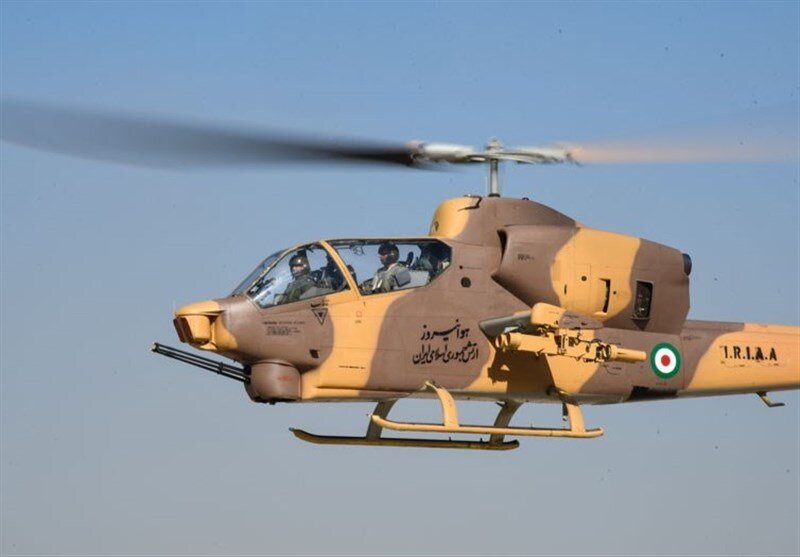Iranian army equips helicopters with night-vision gear, missiles

TEHRAN - Iran's Army Ground Force's airborne division has outfitted its fleet of helicopters with night-vision gear and potent missiles.
General Yousef Qorbani, Commander of the Army Ground Force's Airborne Division, said at a military ceremony in the northeastern city of Mashhad on Saturday that the copters at his disposal have been equipped with night-vision systems and missiles that have successfully hit targets kilometers away.
He also mentioned that local knowledge-based firms have helped the Army manufacture components of military equipment and modern weaponry.
The commander cautioned the country's ultra-regional adversaries that the Islamic Republic is closely monitoring all movements with modern equipment and is working hard to retain the country's deterrent strength.
According to the general, Iranian military troops have guaranteed security and stability along the country's borders.
The Airborne Division of the Ground Force initiated a program in April 2018 to upgrade all helicopters with night-vision cameras to improve aircraft capabilities during night missions.
The Iranian Army is believed to have the most powerful helicopter fleet in the West Asia.
Navy begins escort operations in Red Sea
Iranian Navy Commander Rear Admiral Shahram Irani has said a flotilla of Iranian warships is escorting the country's commercial vessels in the Red Sea and the Gulf of Aden.
The Dena destroyer, Bandar Abbas logistic-combat warship, and Tunb auxiliary warship compose the Navy's 80th flotilla, according to the commander.
He stated that military warships are now conducting operations in the Red Sea and the Gulf of Aden, and that the navy forces are escorting Iranian commercial vessels including oil tankers in those locations.
A handful of Navy cadets are also trained aboard the three military ships, according to Rear Admiral Irani.
During its international mission, the flotilla may call at a number of friendly and adjacent countries, according to him.
Since November 2008, the Iranian Navy has been conducting patrols in the Gulf of Aden to protect merchant containers and oil tankers owned or leased by Iran or other countries, in accordance with international efforts to combat piracy.
Commander of the Islamic Revolution Guards Corp (IRGC) Navy said on February 18 that security in the Persian Gulf is owed to Iran’s intelligence superiority, highlighting preparation for defending the territorial waters and the country’s security interests.
Admiral Alireza Tangsiri made the remarks while visiting IRGC naval units in the northern Persian Gulf region to closely monitor combat readiness and capability of the naval forces.
“With full monitoring and intelligence superiority on the situation in the northern Persian Gulf region, stable and desirable security has been established in this region,” Tangsiri remarked.
The admiral was also informed by the commanders about the combat capability of the operational units.
Later the commander said, “The purpose of continuing these visits and observing the situation of the units stationed in the northern region of the Persian Gulf, is to check the latest status of the units' combat readiness and the sea fighters in the heart of the third IRGC naval area.”
The admiral added field studies show a spirit of religious fervor, courage and bravery by his forces and the full readiness of operational systems and equipment in all actual combat situations.
On January 21, Iran, Russia, and China held naval drills in northern parts of the Indian Ocean.
The exercise, dubbed “naval security belt combined war game 2022”, covered an area of 17,000 square kilometers.
The drill involved marine and airborne units of the regular army, the IRGC Navy, and flotillas from China and Russia.
“Together for peace and security” is the theme of the exercise, Admiral Mostafa Tajeddini, the drill spokesman, said on 20 January.
“The purpose of holding the war game is to strengthen security and its fundamentals in the region, promote multilateral cooperation among the three countries, display the three countries’ goodwill and capability to jointly support world peace and maritime security, and create a maritime community with a common future,” Tasnim quoted Tajeddini as saying.
Forces from the three countries practice various tactics and operations, such as rescuing blazing vessels, saving hijacked vessels, shooting at targets, nocturnal shooting at aerial targets, and other tactical maneuvers.
Tajeddini added the drill was aimed at improving security of international maritime trade, countering piracy and maritime terrorism, exchange of information in naval rescue and relief operations, and exchange of operational and tactical experiences.
This was the third joint naval drill among Iran, Russia, and China.
